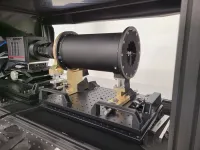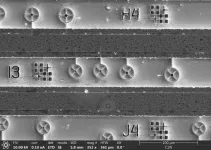(Press-News.org) Southwest Research Institute has won a $60 million contract to build three coronagraphs for the National Oceanic and Atmospheric Administration (NOAA). SwRI’s novel Space Weather Solar Coronagraph (SwSCOR) is NOAA’s next-generation instrument to provide early detection and characterization of Earth-directed coronal mass ejections (CMEs).
CMEs are huge bursts of coronal plasma threaded with intense magnetic fields ejected from the Sun over the course of several hours. CMEs arriving at Earth can generate geomagnetic storms, which can cause anomalies in and disruptions to modern conveniences such as electronic grids and GPS systems. Coronagraphs are instruments that block out light emitted by the Sun’s surface so that its outer atmosphere, or corona, can be observed.
“We’re very excited to work with NOAA and NASA, and provide this important space weather forecasting infrastructure,” said SwRI’s Dr. Craig DeForest, who is leading the project. “Routine images of the solar corona are as important to space weather forecasting as spaceborne imagery is to terrestrial weather forecasting. SwSCOR will be an important part of our nation’s infrastructure.”
SwSCOR will track space weather creating images of the corona every 90 seconds from 2.7 to 22 solar radii, similar to the current CCOR coronagraph recently launched on GOES. The instrument suite includes both flight hardware and rapid data reduction software, which will deliver processed images to NOAA forecasters within minutes of a solar event.
“SwRI has a long history of developing cutting-edge space instruments and technology, and SwSCOR continues that tradition,” said DeForest. “We’ve simplified the design for longevity and stability, and optimized each part of the instrument, including an advanced occulter, for manufacturability and performance.”
Stray light is the largest challenge of coronagraph design. Coronal structures a few degrees away from the Sun are a billion times fainter than the Sun itself. Diffraction injects stray light into the optics as sunlight scatters around the occulter in front of the instrument. Multi-disk coronagraph occulters cut stray light by many orders of magnitude. Adding more disks yields more occultation but tightens the machining or assembly tolerance, making them very challenging to machine.
“SwSCOR has a novel occulter with specific design features that make it easier to fabricate,” DeForest said. “Modern occulters require extremely precise shapes. We’ve adopted several techniques from optical manufacturing to improve that precision while keeping the process feasible and reliable.”
By detecting Earth-directed coronal mass ejections shortly after they erupt, the instruments allow the longest possible lead time for geomagnetic storm watchers. With this forewarning, public and private organizations affected by space weather can take actions to protect their assets. The coronagraphs will also provide data continuity from the Space Weather follow-on Lagrange 1 mission.
SwRI designed SwSCOR using internal funding, incorporating heritage processes and facilities from the development of the Polarimeter to Unify the Corona and Heliosphere mission’s Wide-Field Imager (PUNCH/WFI). SwSCOR will be developed at SwRI’s Solar System Science and Exploration Division, in newly built laboratory facilities in downtown Boulder, Colorado.
DeForest is also the principal investigator of PUNCH, a NASA Small Explorer (SMEX) mission set to launch in 2025, which is designed to better understand how the mass and energy of the Sun’s corona become the solar wind that fills the solar system.
Southwest Research Institute has won a $60 million contract to build three coronagraphs for the National Oceanic and Atmospheric Administration (NOAA). SwRI’s novel Space Weather Solar Coronagraph (SwSCOR) is NOAA’s next-generation instrument to provide early detection and characterization of Earth-directed coronal mass ejections (CMEs).
CMEs are huge bursts of coronal plasma threaded with intense magnetic fields ejected from the Sun over the course of several hours. CMEs arriving at Earth can generate geomagnetic storms, which can cause anomalies in and disruptions to modern conveniences such as electronic grids and GPS systems. Coronagraphs are instruments that block out light emitted by the Sun’s surface so that its outer atmosphere, or corona, can be observed.
“We’re very excited to work with NOAA and NASA, and provide this important space weather forecasting infrastructure,” said SwRI’s Dr. Craig DeForest, who is leading the project. “Routine images of the solar corona are as important to space weather forecasting as spaceborne imagery is to terrestrial weather forecasting. SwSCOR will be an important part of our nation’s infrastructure.”
SwSCOR will track space weather creating images of the corona every 90 seconds from 2.7 to 22 solar radii, similar to the current CCOR coronagraph recently launched on GOES. The instrument suite includes both flight hardware and rapid data reduction software, which will deliver processed images to NOAA forecasters within minutes of a solar event.
“SwRI has a long history of developing cutting-edge space instruments and technology, and SwSCOR continues that tradition,” said DeForest. “We’ve simplified the design for longevity and stability, and optimized each part of the instrument, including an advanced occulter, for manufacturability and performance.”
Stray light is the largest challenge of coronagraph design. Coronal structures a few degrees away from the Sun are a billion times fainter than the Sun itself. Diffraction injects stray light into the optics as sunlight scatters around the occulter in front of the instrument. Multi-disk coronagraph occulters cut stray light by many orders of magnitude. Adding more disks yields more occultation but tightens the machining or assembly tolerance, making them very challenging to machine.
“SwSCOR has a novel occulter with specific design features that make it easier to fabricate,” DeForest said. “Modern occulters require extremely precise shapes. We’ve adopted several techniques from optical manufacturing to improve that precision while keeping the process feasible and reliable.”
By detecting Earth-directed coronal mass ejections shortly after they erupt, the instruments allow the longest possible lead time for geomagnetic storm watchers. With this forewarning, public and private organizations affected by space weather can take actions to protect their assets. The coronagraphs will also provide data continuity from the Space Weather follow-on Lagrange 1 mission.
SwRI designed SwSCOR using internal funding, incorporating heritage processes and facilities from the development of the Polarimeter to Unify the Corona and Heliosphere mission’s Wide-Field Imager (PUNCH/WFI). SwSCOR will be developed at SwRI’s Solar System Science and Exploration Division, in newly built facilities in downtown Boulder, Colorado.
DeForest is also the principal investigator of PUNCH, a NASA Small Explorer (SMEX) mission set to launch in 2025, which is designed to better understand how the mass and energy of the Sun’s corona become the solar wind that fills the solar system.
END
NASA awards SwRI $60 million contract to develop next-generation coronagraphs
SwSCOR will help NOAA predict geomagnetic storms and protect Earth assets
2024-11-18
ELSE PRESS RELEASES FROM THIS DATE:
Reducing antimicrobial resistance: accelerated efforts are needed to meet the EU targets
2024-11-18
Between 2019 and 2023, antibiotic consumption in the EU increased by 1%, moving further away from the 2030 target of a 20% reduction recommended by the Council of the European Union.
Although there have been significant reductions in methicillin-resistant Staphylococcus aureus bloodstream infections during the same period, the situation in other critical areas, such as carbapenem-resistant Klebsiella pneumoniae bloodstream infections, has worsened, with an increase in incidence by almost 60% between 2019 and 2023. This represents a growing threat to patients in hospitals across the EU, particularly since very few therapeutic options remain available to treat patients infected with ...
Gaming for the good!
2024-11-18
So maybe the naysayers and detractors of online gaming and its ill effects on youth need to stand down. That’s what science is telling us in a new report in the journal Human Resource Development International from Melika Shirmohammadi, assistant professor at the UH College of Technology.
The article reports that - contrary to popular belief - massive multiplayer online gamers learn by gaming and their skills in the workplace are enriched by those seemingly endless hours previously thought of as frittering away time.
"Online gaming often ...
Early adoption of sodium-glucose cotransporter-2 inhibitor in patients hospitalized with heart failure with mildly reduced or preserved ejection fraction
2024-11-18
About The Study: In this study of discharge prescription of a sodium-glucose cotransporter-2 inhibitor (SGLT2i) among patients hospitalized for heart failure, prescription rates increased substantially within 2 years after publication of clinical trial evidence documenting benefit, although considerable variation in rates was found, highlighting the need to understand strategies used by higher prescribing centers to increase SGLT2i adoption.
Corresponding Author: To contact the corresponding author, ...
New study finds atrial fibrillation common in newly diagnosed heart failure patients, and makes prognosis significantly worse
2024-11-18
A new study by researchers at Intermountain Health in Salt Lake City finds that 40 percent of newly diagnosed heart failure patients also have atrial fibrillation – a combination of cardiac disorders that researchers found results in significantly poorer outcomes for patients.
Findings from the Intermountain Health study demonstrate the need for physicians to screen newly diagnosed heart failure patients for atrial fibrillation to ensure patients are getting the best care possible, researchers said.
“Atrial fibrillation can make heart failure much more problematic, and more complex to treat,” said Heidi T. May, PhD, principal investigator of the study and cardiovascular ...
Chitnis receives funding for study of wearable ultrasound systems
2024-11-18
Parag Chitnis, Associate Professor, Bioengineering, College of Engineering and Computing (CEC), received funding for the project: “MTEC-23-06-USAMRDC-MultiTopic-105; Tendon and Joint Injury Prevention and Reduction using Wearable Ultrasound Systems.”
He leads a multi-disciplinary team that aims to produce a new class of wearable hands-free ultrasound systems. Specifically, this system builds on patented technology to provide structural and functional measures for assessing muscle-tendon interactions for preventing tendon overuse injury and assessing joint function, injury, and recovery.
Chitnis received $1,856,023 from Advanced Technology ...
Weisburd receives funding for safer stronger together initiative
2024-11-18
David Weisburd, Distinguished Professor, Criminology, Law and Society, College of Humanities and Social Sciences (CHSS); Executive Director, Center for Evidence-Based Crime Policy (CEBCP), received funding for: “Safer Stronger Together (SST) Initiative: An evaluation of the impact of a place-based social intervention on youth and their families.”
Weisburd will evaluate baseline behaviors and attitudes of clients in the recently launched Safer Stronger Together (SST) Initiative in Maryland. A future proposal will be geared toward gaining outcome data.
He ...
Kaya advancing AI literacy
2024-11-18
Erdogan Kaya, Assistant Professor, College of Education and Human Development (CEHD), received funding for the project: “EducateAI DCL: Cultivating Artificial Intelligence Literacy through Linguistically Inclusive Integrated Elementary Curriculum via Educational Robotics.”
He and his colleagues aim to develop a linguistically inclusive integrated Artificial Intelligence (AI) curriculum that specifically supports emergent multilingual learners (EMLs), using educational robotics to teach ...
Wang studying effects of micronutrient supplementation
2024-11-18
Dongqing Wang, Assistant Professor, Global and Community Health, College of Public Health, received funding for the project: “Effects of micronutrient supplementation on maternal and infant micronutrient status: a secondary analysis for Tanzania, and a systematic review and meta-analysis for low- and middle-income countries.”
Wang will lead the secondary analysis using existing data from a randomized controlled trial in Tanzania.
He aims to investigate the effect of multiple micronutrient ...
Quandela, the CNRS, Université Paris-Saclay and Université Paris Cité join forces to accelerate research and innovation in quantum photonics
2024-11-18
On 13th of November 2024, Quandela, the CNRS, Université Paris-Saclay, and Université Paris Cité inaugurated at the Centre for Nanoscience and Nanotechnology (CNRS/Université Paris-Saclay/Université Paris Cité) the QDlight associated research laboratory focusing on research in quantum photonics, which is to say the art of controlling light in the quantum regime inside nanoscale devices. Over the course of six years, the teams will expand scientific cooperation ...
Pulmonary vein isolation with optimized linear ablation vs pulmonary vein isolation alone for persistent AF
2024-11-18
About The Study: Among patients with persistent atrial fibrillation, linear ablation combined with ethanol infusion of the vein of Marshall in addition to pulmonary vein isolation significantly improved freedom from atrial arrhythmias within 12 months compared with pulmonary vein isolation alone.
Corresponding Authors: To contact the corresponding authors, email Changsheng Ma, MD, (chshma@vip.sina.com) and Chenyang Jiang, MD, (jiangchenyangmail@163.com).
To access the embargoed study: Visit our ...
LAST 30 PRESS RELEASES:
Numbers in our sights affect how we perceive space
SIMJ announces global collaborative book project in commemoration of its 75th anniversary
Air pollution exposure and birth weight
Obstructive sleep apnea risk and mental health conditions among older adults
How talking slows eye movements behind the wheel
The Ceramic Society of Japan’s Oxoate Ceramics Research Association launches new international book project
Heart-brain connection: international study reveals the role of the vagus nerve in keeping the heart young
Researchers identify Rb1 as a predictive biomarker for a new therapeutic strategy in some breast cancers
Survey reveals ethical gaps slowing AI adoption in pediatric surgery
Stimulant ADHD medications work differently than thought
AI overestimates how smart people are, according to HSE economists
HSE researchers create genome-wide map of quadruplexes
Scientists boost cell "powerhouses" to burn more calories
Automatic label checking: The missing step in making reliable medical AI
Low daily alcohol intake linked to 50% heightened mouth cancer risk in India
American Meteorological Society announces Rick Spinrad as 2026 President-Elect
Biomass-based carbon capture spotlighted in newly released global climate webinar recording
Illuminating invisible nano pollutants: advanced bioimaging tracks the full journey of emerging nanoscale contaminants in living systems
How does age affect recovery from spinal cord injury?
Novel AI tool offers prognosis for patients with head and neck cancer
Fathers’ microplastic exposure tied to their children’s metabolic problems
Research validates laboratory model for studying high-grade serous ovarian cancer
SIR 2026 delivers transformative breakthroughs in minimally invasive medicine to improve patient care
Stem Cell Reports most downloaded papers of 2025 highlight the breadth and impact of stem cell research
Oxford-led study estimates NHS spends around 3% of its primary and secondary care budget on the health impacts of heat and cold in England
A researcher’s long quest leads to a smart composite breakthrough
Urban wild bees act as “microbial sensors” of city health.
New study finds where you live affects recovery after a hip fracture
Forecasting the impact of fully automated vehicle adoption on US road traffic injuries
Alcohol-related hospitalizations from 2016 to 2022
[Press-News.org] NASA awards SwRI $60 million contract to develop next-generation coronagraphsSwSCOR will help NOAA predict geomagnetic storms and protect Earth assets




